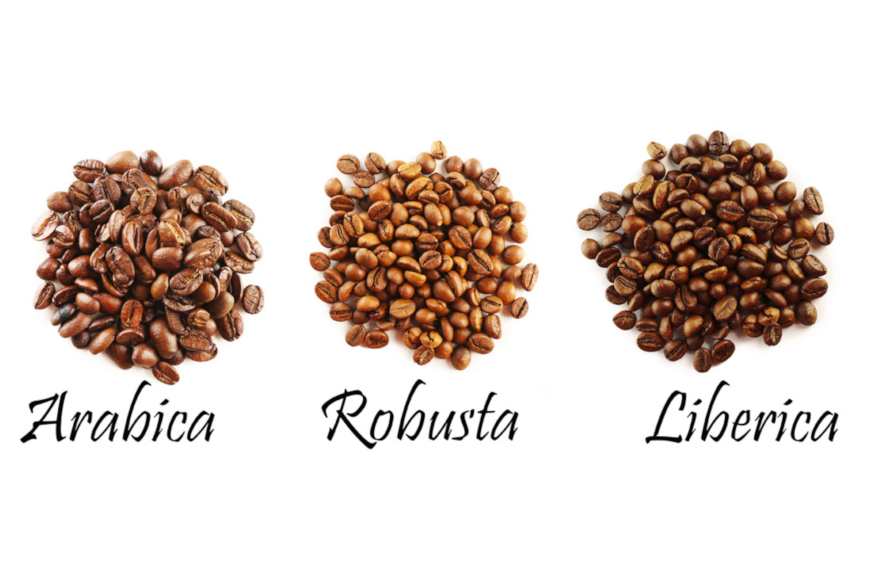- Δωρεάν Μεταφορικά για αγορές άνω των 69€
Οι βασικές διαφορές μεταξύ των ποικιλιών Arabica και Robusta

Υπάρχουν πάνω από 100 είδη φυτών του γένους “Coffea”, αλλά μόνο τρία καλλιεργούνται με σκοπό την εμπορική κατανάλωση καφέ. Το Coffea Arabica (Arabica), το Coffea Canephora που είναι γνωστό ως Robusta και το Coffea Liberica που είναι γνωστό ως Liberian Coffee.
Η ποικιλία Liberian coffee καλλιεργείται κυρίως στη Λιβερία, τη Μαλαισία και την Ακτή Ελεφαντοστού και αποτελεί μόνο το 1% της παγκόσμιας αγοράς του καφέ. Οι πιο δημοφιλείς και εμπορικές ποικιλίες είναι οι Arabica και Robusta. Οι κυριότερες διαφορές τους είναι:
1. Γεύση: Οι κόκκοι Arabica έχουν γλυκιά και απαλή γεύση και υψηλή οξύτητα. Πριν το καβούρδισμα έχουν άρωμα μπλε βατόμουρου. Μετά το καβούρδισμα το άρωμά τους γίνεται έντονο με νότες φρούτων και ζάχαρης. Περιλαμβάνουν ένα ευρύ φάσμα διαφορετικών γεύσεων που εξαρτάται από την ποικιλία και την περιοχή καλλιέργειας.
Οι κόκκοι Robusta έχουν πιο βαριά και πικρή γεύση χωρίς μεγάλη ποικιλία γεύσεων. Συχνά, αναφέρεται ότι έχουν γεύση βρώμης ή καμένου λάστιχου. Είναι κατώτερης ποιότητας από την ποικιλία Arabica. Σπανίως, συναντά κανείς κόκκους Robusta υψηλής ποιότητας και αυτοί υπάρχουν σε μικρές ποσότητες.
2. Συνθήκες Καλλιέργειας: Το φυτό Arabica συνήθως μεγαλώνει από 2,5m ως 4,5m ύψος, ευδοκιμεί σε υψόμετρα από 600m ως 2200m, σε θερμοκρασίες από 15 ΟC ως 24ΟC και ετήσια βροχόπτωση 1200mm ως 2200mm. Ο Arabica καλλιεργείται στην Αφρική, στην Παπούα Νέα Γουινέα, στην Ινδία, αλλά κυρίως, στη Λατινική Αμερική με τη Βραζιλία να είναι ο μεγαλύτερος παραγωγός.
Το φυτό Robusta είναι λίγο πιο ψηλό, από 4,5m ως 6,5m και ευδοκιμεί σε υψόμετρα από 0m ως 800m, σε θερμοκρασίες από 18 ΟC ως 36ΟC και ετήσια βροχόπτωση 2200mm ως 3000mm. Ο Robusta καλλιεργείται στο Ανατολικό Ημισφαίριο και κυρίως στην Αφρική και την Ινδονησία. Υπάρχουν και χώρες, όπως η Βραζιλία και η Ινδία, που παράγουν και τις δύο ποικιλίες.

3. Καφεΐνη: Ο Robusta έχει σχεδόν διπλάσια καφεΐνη από τον Arabica και γι' αυτό έχει πιο πικρή γεύση. Η ποσότητα όμως της καφεΐνης λειτουργεί ως χημική άμυνα και καθιστά το φυτό πιο ανθεκτικό στα έντομα και τους μύκητες.
4. Περιεκτικότητα Λιπιδίων και Σακχάρων: Ο Arabica περιέχει περίπου 60% παραπάνω λιπίδια και 50% παραπάνω σάκχαρα από τον Robusta. Αυτό έχει ως αποτέλεσμα να δημιουργούνται διάφορες αρωματικές ενώσεις κατά τη διαδικασία του ψησίματος και να επιτυγχάνεται καλύτερα δομημένο σώμα.
5. Σχήμα Κόκκου: Οι κόκκοι Arabica είναι πιο μεγάλοι και με ελλειπτικό σχήμα σε σχέση με τους κόκκους Robusta. Υπάρχουν βέβαια και διαφορές στην κατασκευαστική δομή των κόκκων, γεγονός που εξηγεί, γιατί έχουν διαφορετική συμπεριφορά στις ίδιες συνθήκες ψησίματος.

6. Οικονομικά στοιχεία: Τα φυτά της ποικιλίας Robusta είναι πιο ανθεκτικά στα έντομα, φτάνουν σε μικρότερο χρονικό διάστημα σε πλήρη παραγωγή, έχουν σχεδόν διπλάσια απόδοση ανά φυτό και οι καλλιέργειες είναι πιο εύκολα εκμεταλλεύσιμες λόγω του μικρού υψόμετρου. Όλα τα παραπάνω στοιχεία έχουν ως αποτέλεσμα το κόστος ανά κιλό να είναι μικρότερο από τον Arabica. Σε γενικές γραμμές, ο Arabica είναι καφές ανώτερης ποιότητας και αρκετά πιο ακριβός. Ο Robusta χρησιμοποιείται κυρίως για να μειώσει το κόστος του καφέ ή/και να βελτιώσει την κρέμα και σε στιγμιαίους καφέδες. Περίπου 70% της παγκόσμιας παραγωγής είναι Arabica και 30% είναι Robusta.
Βέβαια, ένας καφές 100% Arabica δε σημαίνει ότι είναι ανώτερης ποιότητας. Υπάρχουν ποικιλίες Arabica που είναι κατώτερες ποιοτικά από κάποιες καλές ποικιλίες Robusta. Έτσι κι αλλιώς, η γεύση είναι καθαρά υποκειμενική. Για κάποιους μπορεί η φρουτένια γεύση του Arabica να είναι ενοχλητική, ενώ η κρέμα και η πικράδα του Robusta να είναι ευχάριστη. Πολλοί επιλέγουν χαρμάνια από Arabica και Robusta, γιατί απολαμβάνουν τις ιδιαιτερότητες και των δύο ποικιλιών. Δοκιμάστε λοιπόν, διαφορετικά χαρμάνια και αποφασίστε εσείς ποιο είναι το ιδανικό για εσάς.

